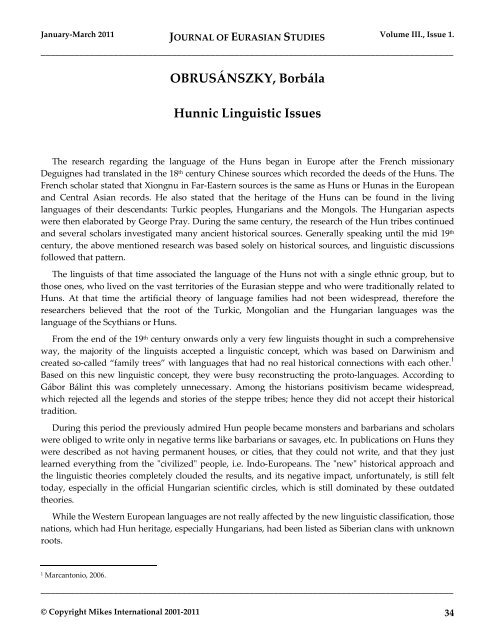JOURNAL OF EURASIAN STUDIES
JOURNAL OF EURASIAN STUDIES
JOURNAL OF EURASIAN STUDIES
Create successful ePaper yourself
Turn your PDF publications into a flip-book with our unique Google optimized e-Paper software.
January-March 2011 <strong>JOURNAL</strong> <strong>OF</strong> <strong>EURASIAN</strong> <strong>STUDIES</strong> Volume III., Issue 1.<br />
_____________________________________________________________________________________<br />
OBRUSÁNSZKY, Borbála<br />
Hunnic Linguistic Issues<br />
The research regarding the language of the Huns began in Europe after the French missionary<br />
Deguignes had translated in the 18 th century Chinese sources which recorded the deeds of the Huns. The<br />
French scholar stated that Xiongnu in Far-Eastern sources is the same as Huns or Hunas in the European<br />
and Central Asian records. He also stated that the heritage of the Huns can be found in the living<br />
languages of their descendants: Turkic peoples, Hungarians and the Mongols. The Hungarian aspects<br />
were then elaborated by George Pray. During the same century, the research of the Hun tribes continued<br />
and several scholars investigated many ancient historical sources. Generally speaking until the mid 19 th<br />
century, the above mentioned research was based solely on historical sources, and linguistic discussions<br />
followed that pattern.<br />
The linguists of that time associated the language of the Huns not with a single ethnic group, but to<br />
those ones, who lived on the vast territories of the Eurasian steppe and who were traditionally related to<br />
Huns. At that time the artificial theory of language families had not been widespread, therefore the<br />
researchers believed that the root of the Turkic, Mongolian and the Hungarian languages was the<br />
language of the Scythians or Huns.<br />
From the end of the 19 th century onwards only a very few linguists thought in such a comprehensive<br />
way, the majority of the linguists accepted a linguistic concept, which was based on Darwinism and<br />
created so-called “family trees” with languages that had no real historical connections with each other. 1<br />
Based on this new linguistic concept, they were busy reconstructing the proto-languages. According to<br />
Gábor Bálint this was completely unnecessary. Among the historians positivism became widespread,<br />
which rejected all the legends and stories of the steppe tribes; hence they did not accept their historical<br />
tradition.<br />
During this period the previously admired Hun people became monsters and barbarians and scholars<br />
were obliged to write only in negative terms like barbarians or savages, etc. In publications on Huns they<br />
were described as not having permanent houses, or cities, that they could not write, and that they just<br />
learned everything from the "civilized" people, i.e. Indo-Europeans. The "new" historical approach and<br />
the linguistic theories completely clouded the results, and its negative impact, unfortunately, is still felt<br />
today, especially in the official Hungarian scientific circles, which is still dominated by these outdated<br />
theories.<br />
While the Western European languages are not really affected by the new linguistic classification, those<br />
nations, which had Hun heritage, especially Hungarians, had been listed as Siberian clans with unknown<br />
roots.<br />
1 Marcantonio, 2006.<br />
_____________________________________________________________________________________<br />
© Copyright Mikes International 2001-2011 34

















